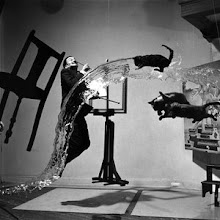 What becomes of old art forms as new technologies develop? It is a difficult to answer, because it is quite rare to see entire art forms die off. Usually there are still a few artist that cling to old techniques. Consider photography, nobody makes callotypes or daguerrotypes anymore. The question arises, as new technologies create new techniques from creating and showing art, are we still creating the same art? Fundamentally in many cases it is the same idea. Graffiti to cave painting, photo shop to canvas painting, drawn animation to FBF computer animation. However there entirely new forms that have arisen from technologies such as photography and video that crate a whole different art. This is mentioned in the article that these form pierce into reality and demonstrate a deeper meaning in our daily real world. However previous art forms had to recreate and interpret these using human imagination and bias.
What becomes of old art forms as new technologies develop? It is a difficult to answer, because it is quite rare to see entire art forms die off. Usually there are still a few artist that cling to old techniques. Consider photography, nobody makes callotypes or daguerrotypes anymore. The question arises, as new technologies create new techniques from creating and showing art, are we still creating the same art? Fundamentally in many cases it is the same idea. Graffiti to cave painting, photo shop to canvas painting, drawn animation to FBF computer animation. However there entirely new forms that have arisen from technologies such as photography and video that crate a whole different art. This is mentioned in the article that these form pierce into reality and demonstrate a deeper meaning in our daily real world. However previous art forms had to recreate and interpret these using human imagination and bias.While the old techniques and mediums for art still exist, largely a lot of the principles that come with them can be lost. Tens of thousands of people can use photo shop, but probably only a hand ful of them probably know what the burn/dodge tool actually means. In fact such an effect can be replicated by different means than that algorithm. That is if we wish to replicate the effect at all. A lot of post photographic techniques arise out of a need to fix a picture because the machine (camera) failed to represent something the way we want it. It is possible for such concepts to drop out completely. (We do however see a revival of intentionally making error in film, to recreate our old feeling of film.) We spend a lot of time in 3D animation avoiding the computer perfect look.
Something that old mediums and techniques do face today is new expectations. The people viewing these mediums expect a level of convenience and an amount of public notoriety that can draw their interest. Like the British dude said, the days of patronage are over. It can also be argued we expect more content than used to be expected. many musician release multiple albums to stay "relevant," and using old techniques and mediums usually take longer to achieve the desired effect. The expectations are simply different, especially as new technology streamlines the art making process.




